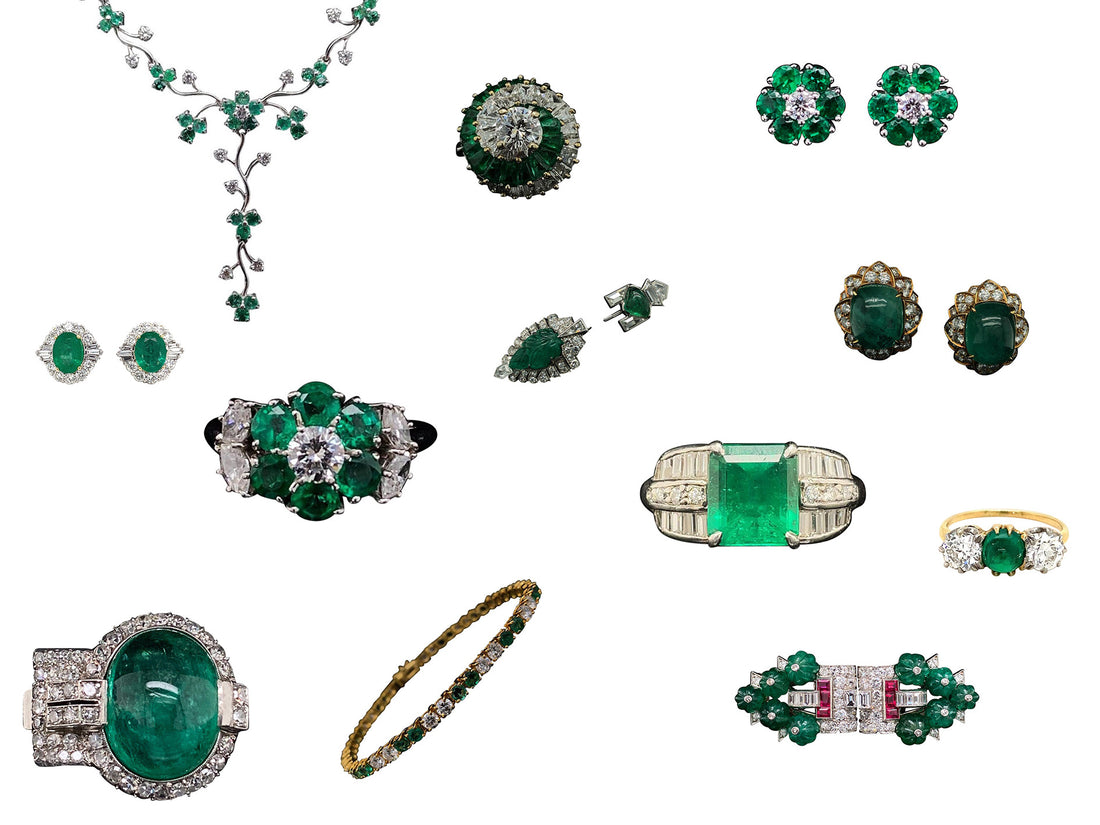Part 5 of our series and today we are looking at emeralds! Emerald is also the birthstone for May babies which makes a lot of sense as they represent life, nature and new beginnings - essentially Spring!
Emeralds have not only been around for years but loved for all of them as well. Emerald’s name comes from the ancient Greek word for green ‘smaragdus’. Pliny the Elder described emerald in his Natural History, published in the first century AD as ‘nothing greens greener’. In his book he describes the use of emerald by early lapidaries who ‘have no better method of restoring their eyes than by looking at the emerald, it’s soft green colour comforting and removing their weariness and lassitude’. Even today, the colour green is known to relieve stress and eye strain.

The first known emerald mines were in Egypt, dating from at least 330 BC into the 1700s. Cleopatra was known to have a passion for emerald and used it in her royal jewellery. She did a great deal to popularise the gem. She believed emeralds to be sacred symbols of fertility and immortality. Reportedly Cleopatra adorned herself and her palace with emeralds and also gave them as gifts to dignitaries. It’s most likely that she intended this as a display of wealth and power.
People believed that emeralds could conjure up riches, power and eloquence if worn as talismans. The gem was also known to strengthen memory and sharpen wits. It’s most valuable power was perhaps bestowing the ability to predict future events. Legend states that the wearer would place an emerald under their tongue to reveal the future, the truth and be protected against evil spirits. The gem was also thought to cure diseases like cholera and malaria. The legend also states that emerald was one of the four precious stones given by God to King Solomon. These four stones were said to have given the king power over all creation.

As the revealer of truths, it seems fitting that emeralds could reportedly cut through all illusions and spells, including the truth or falsity of a lover’s oath. Some believed it could also dampen lust but many physics now believe this is due to the emerald revealing the truth about objects of infatuation.
Emeralds have been used in stories across time - most notably stories based on cites or places. Many ancient tales about India tell of a mysterious and legendary city, full of wealth, walls and entire temples made from emeralds. Plants would drip in rubies and emeralds and it was suggested that those lucky and virtuous enough could locate these cities and find the jewels as their reward. We don’t know how true this is but the tale of cities seems to have mirrored today. For example, Ireland is known as the Emerald Isle, Seattle is the Emerald City and Thailand’s most sacred religious icon is called the Emerald Buddha despite being craved from green jade.

Hindus believe that those offering emeralds to the god Krishna will be rewarded and be given knowledge f the soul and the eternal in return. Hindu teachings also associate emeralds with the planet Mercury. Whereas Western traditions associate emeralds with the planet Venus. Perhaps this is from the Greek Goddess Venus who was the goddess of love and beauty and the stone was said to protect from unfaithfulness. If the heart was loyal, the gem would glow a beautiful green, but if the heart went astray, it would turn a lifeless colour.
Around the time of the Spanish Conquest (1519) the people of the Peruvian City, Manta, worshipped an emerald the ‘size of an ostrich egg’. This was said to have belonged to the goddess Umina. Her priests brought her out of her temple only on ‘feast days’ and according to them her followers would worship ‘the mother emerald’ by bringing her smaller emeralds. When the Spaniards conquered the town, they seized the immense store of emeralds. The conquistadors smashed many of these gems on an anvil to see if they were real - mistakenly believing that true emeralds would withstand the test. Emeralds can have a very high hardness of up to 8, however they are much more brittle than other members of the beryl family due to their many inclusions. Even diamonds with a hardness of 10 would shatter if smashed onto an anvil! Hardness only measures resistance to scratching, emeralds still require very gentle treatment.

Emeralds have a wealth of history to them and need to be treated gently. The best way to clean your emeralds is with warm soapy water or a warm soapy cloth. Do not soak the emerald in soapy water and avoid harsh detergents that might dilute or remove oils from the stone. Never soak the stone in solvents such as alcohol, acetone or paint thinner. Now you have your emerald knowledge we hope you can wear yours with pride!

